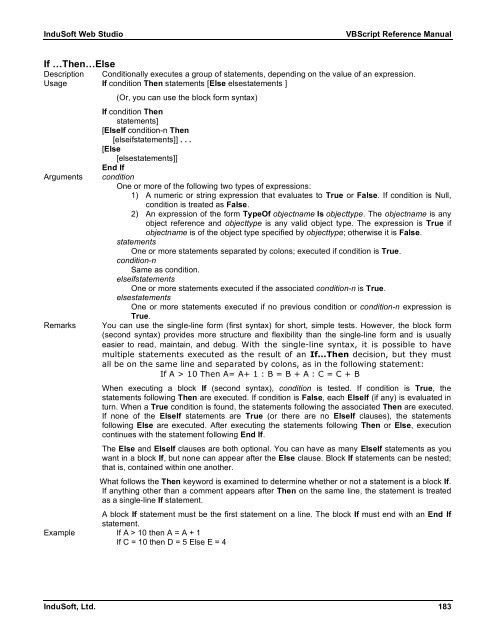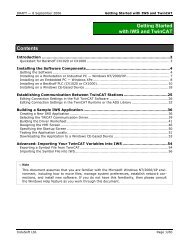VBScript Reference Manual for InduSoft Web Studio
VBScript Reference Manual for InduSoft Web Studio
VBScript Reference Manual for InduSoft Web Studio
You also want an ePaper? Increase the reach of your titles
YUMPU automatically turns print PDFs into web optimized ePapers that Google loves.
<strong>InduSoft</strong> <strong>Web</strong> <strong>Studio</strong> <strong>VBScript</strong> <strong>Reference</strong> <strong>Manual</strong><br />
If …Then…Else<br />
Description Conditionally executes a group of statements, depending on the value of an expression.<br />
Usage If condition Then statements [Else elsestatements ]<br />
(Or, you can use the block <strong>for</strong>m syntax)<br />
If condition Then<br />
statements]<br />
[ElseIf condition-n Then<br />
[elseifstatements]] . . .<br />
[Else<br />
[elsestatements]]<br />
End If<br />
Arguments condition<br />
One or more of the following two types of expressions:<br />
1) A numeric or string expression that evaluates to True or False. If condition is Null,<br />
condition is treated as False.<br />
2) An expression of the <strong>for</strong>m TypeOf objectname Is objecttype. The objectname is any<br />
object reference and objecttype is any valid object type. The expression is True if<br />
objectname is of the object type specified by objecttype; otherwise it is False.<br />
statements<br />
One or more statements separated by colons; executed if condition is True.<br />
condition-n<br />
Same as condition.<br />
elseifstatements<br />
One or more statements executed if the associated condition-n is True.<br />
elsestatements<br />
One or more statements executed if no previous condition or condition-n expression is<br />
True.<br />
Remarks You can use the single-line <strong>for</strong>m (first syntax) <strong>for</strong> short, simple tests. However, the block <strong>for</strong>m<br />
(second syntax) provides more structure and flexibility than the single-line <strong>for</strong>m and is usually<br />
easier to read, maintain, and debug. With the single-line syntax, it is possible to have<br />
multiple statements executed as the result of an If...Then decision, but they must<br />
all be on the same line and separated by colons, as in the following statement:<br />
If A > 10 Then A= A+ 1 : B = B + A : C = C + B<br />
When executing a block If (second syntax), condition is tested. If condition is True, the<br />
statements following Then are executed. If condition is False, each ElseIf (if any) is evaluated in<br />
turn. When a True condition is found, the statements following the associated Then are executed.<br />
If none of the ElseIf statements are True (or there are no ElseIf clauses), the statements<br />
following Else are executed. After executing the statements following Then or Else, execution<br />
continues with the statement following End If.<br />
The Else and ElseIf clauses are both optional. You can have as many ElseIf statements as you<br />
want in a block If, but none can appear after the Else clause. Block If statements can be nested;<br />
that is, contained within one another.<br />
What follows the Then keyword is examined to determine whether or not a statement is a block If.<br />
If anything other than a comment appears after Then on the same line, the statement is treated<br />
as a single-line If statement.<br />
A block If statement must be the first statement on a line. The block If must end with an End If<br />
statement.<br />
Example If A > 10 then A = A + 1<br />
If C = 10 then D = 5 Else E = 4<br />
<strong>InduSoft</strong>, Ltd. 183



